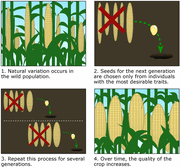(Created page with "thumb|right|335 px [[File:27956_evo_resources_resource_image_364_original.gif|thumb|How to selectively breed corn. University of Californ...") |
(Adding categories) |
||
| Line 18: | Line 18: | ||
Roberts, M., & Schlenker, W. (2009). The evolution of heat tolerance of corn: implications for climate change. Retrieved from[http://www.nber.org/chapters/c11988.pdf <span style="color:windowtext;">http://www.nber.org/chapters/c11988.pdf</span>] <br /> |
Roberts, M., & Schlenker, W. (2009). The evolution of heat tolerance of corn: implications for climate change. Retrieved from[http://www.nber.org/chapters/c11988.pdf <span style="color:windowtext;">http://www.nber.org/chapters/c11988.pdf</span>] <br /> |
||
United States Department of Agriculture Research Service. (2008). ARS timeline. Retrieved from [http://www.ars.usda.gov/is/timeline/corn.htm <span style="color:windowtext;">http://www.ars.usda.gov/is/timeline/corn.htm</span>]</span> |
United States Department of Agriculture Research Service. (2008). ARS timeline. Retrieved from [http://www.ars.usda.gov/is/timeline/corn.htm <span style="color:windowtext;">http://www.ars.usda.gov/is/timeline/corn.htm</span>]</span> |
||
| + | [[Category:Selective breeding]] |
||
Latest revision as of 18:33, 1 November 2013

Genetically Engineered Corn

How to selectively breed corn. University of California Museum of Paleontology's Understanding Evolution (http://evolution.berkeley.edu)
Selective breeding (also called artificial selection) is the process by which humans breed other animals and plants for particular traits. (Wikipedia, 2013).
Pro or Con?
Through selective breeding, scientists have engineered apples to resist disease and pests, powdery mildew, and scab, which are all beneficial for farmers, making more produce, leading to more income (Ferree & Warrington, 2003). However, this process of selective breeding has caused the loss of biodiversity, or the lack of alleles, making there less variety to the phenotype it will carry (Freeman & Herron, 2007). Over the years geneticists have continued to create these hybridized, specialized crops from apples to corn to soybeans. Does it matter that these crops have lost their genetic variation? Can they survive changing environments, without evolving through the process of natural selection because of the lack of genetic variations? Despite the larger crop yield that farmers can produce, I think that eventually this will affect the evolution of crops. Even though hybrid varieties of crops may produce more outcome of crop on less land, I think that overall this will end up being more of a negative aspect than a benefit. Freeman and Herron (2007) discussed that populations without genetic variations may not be able to adapt to their environments, affecting the evolution of crops.
US Crops and Climate Change
What percent of the crops grown in the United States are selectively bred? Corn, for example, has 95 percent of what is planted in the United States is of a hybrid variety. Farmers are producing at least 20 percent more corn on 25 percent fewer acres than in 1930. With the loss of genetic variation, corn will not be able to evolve to particular adaptations (Freeman & Herron, 2007). When 75 percent of genetic diversity has been lost over the last century, adapting to anything is going to be a struggle for many organisms (Biodiveristy, 2013).
One major adaptation that all crops, including corn, will need to adapt to is the changing climate. Corn has a threshold temperature at 84°F, and according to a study by Roberts and Schlenker (2009) varieties of hybrid corn were not able to withstand temperature increases over periods of time, and produced less crop yield than average years. If geneticists or farmers are not around to continue to create new, hybrid varieties of corn, overall the corn will not survive over time. Overall, selective breeding in agriculture will definitely affect the evolution of these crops in a negative way, regardless of a higher production rate, and will require constant supervision from the farmers to ensure the survival of the crop.
Biodiversity. (2013). Grace Communications Foundation. Retrieved fromhttp://www.sustainabletable.org/268/biodiversity
Ferree, D.C., Warrington, I.J. (2003). Apples: Botany, production, and uses. New York, NY: CABI Pub.
Roberts, M., & Schlenker, W. (2009). The evolution of heat tolerance of corn: implications for climate change. Retrieved fromhttp://www.nber.org/chapters/c11988.pdf
United States Department of Agriculture Research Service. (2008). ARS timeline. Retrieved from http://www.ars.usda.gov/is/timeline/corn.htm